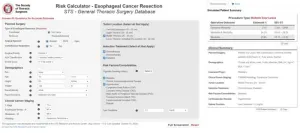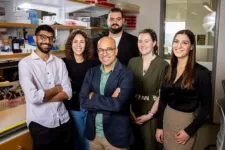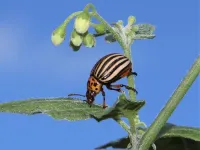(Press-News.org) With time being of the essence for patients facing one of cancer's most dire complications, UCLA researchers are working to create a new test to detect cancer’s spread to the central nervous system on the same day as the doctor’s visit.
When cancer spreads from its primary site, such as the lungs or breast, to the brain or spine, there are well-established methods of treating it. However, when these metastases spread to the cerebrospinal fluid (CSF), a condition known as leptomeningeal disease (LMD), median survival drops to around four months with treatment. If untreated, median survival is measured in weeks.
In addition to its low survivability, LMD is also difficult to detect in a timely manner using existing testing procedures. Currently, it can take several weeks before doctors can confirm whether the cancer has spread to the cerebrospinal fluid and several more weeks after that to determine if a treatment has been effective.
“You can't wait a month or two to establish a diagnosis or see if treatment is working. That is critical time that we do not have,” said Dr. Won Kim, Neurosurgical Director of the Brain Metastasis Program and co-investigator of the study.
As part of a two-year study funded by the National Institutes of Health, Kim and Daniel Kamei, professor of Bioengineering in the UCLA Samueli School of Engineering and principal investigator of the study, are now working to develop a new test that would allow for same-day detection of LMD and allow doctors to monitor the effectiveness of treatments such as chemotherapy in real time.
“One of the challenges is being able to detect very low concentrations of cancer cells in cerebrospinal fluid with a paper-based test,” Kamei said. “Another challenge is being able to determine concentrations of cancer cells since these types of tests generally provide only yes or no answers. Such yes or no answers are all you need to detect for COVID and pregnancy, but for this application, you need to determine if the concentration of cancer cells is decreasing with a particular treatment regimen.”
To accomplish this, Kamei and Kim are working to develop a diagnostic kit that includes sample processing and a specialized paper-assay test, similar to those used in at-home COVID and pregnancy tests. Their goal would be to allow doctors to draw cerebrospinal fluid from the patient and, after processing, apply it to the paper test at the site of care. The test would ideally not only confirm the presence of cancer cells in the cerebrospinal fluid that same day, but also give doctors a measure of the concentration of cancer cells.
With existing tests, the cerebrospinal fluid must be sent to a lab for processing, which can take one to two weeks for results, Kim said. Even worse, the first test typically only has a 50% detection rate, with subsequent tests needed to improve accuracy. Another limitation of these tests is they do not accurately measure disease burden, limiting their usefulness in deciding if a treatment is working or not.
“The real time monitoring of circulating tumor cells allows the doctor to quickly determine whether the treatment is working or not,” Kamei said. “The doctor can then continue or change the treatment regimen based on how the concentration of cancer cells is changing. Obtaining this information in real time is critical given the poor survival rates.”
In addition to reducing time, the test could also reduce the costs of testing for LMD given that the tests are paper-based and do not require lab-processing.
“The infrastructure is there to mass produce these types of paper-based diagnostics with low cost and high shelf life,” Kamei said.
The $375,000, two-year NIH-funded study will include the development of two types of diagnostics and testing with purchased cancer cells and some patient samples.
“If the technologies work with cancer cells, then we'll start testing with cerebrospinal fluid samples from patients,” Kim said. “If we're able to validate this in our human patients for the initial testing phase, we would like to move towards a multicenter clinical trial."
The study is currently underway, with initial results expected in 2026.
END
Study seeks rapid, paper-based test to detect cancer cells in cerebrospinal fluid
UCLA researchers look to create point-of-care test that can confirm diagnosis at the bedside
2024-10-17
ELSE PRESS RELEASES FROM THIS DATE:
Raising happy eaters: Unlocking the secrets of childhood appetite
2024-10-17
URBANA, Ill. — The foundation for healthy eating behavior starts in infancy. Young children learn to regulate their appetite through a combination of biological, psychological, and sociological factors. In a new paper, researchers at the University of Illinois Urbana-Champaign propose a model that explores these factors and their interactions, providing guidelines for better understanding childhood appetite self-regulation.
“When we talk about obesity, the common advice is often to just eat less and exercise more. That’s a simplistic recommendation, which almost makes it seem ...
The Society of Thoracic Surgeons launches two new thoracic surgery risk calculators
2024-10-17
CHICAGO, IL – October 17, 2024 – The Society of Thoracic Surgeons (STS) announces the release of two new risk calculators to inform physician-patient decision-making in thoracic surgery. Engineered using contemporary data from the STS General Thoracic Surgery Database, these interactive tools provide surgeons with accurate, preoperative risk estimations for outcomes of esophagectomy for cancer and pulmonary resection for lung cancer.
The mobile-friendly risk calculators allow surgeons and multidisciplinary ...
FAPESP and CNR plan to launch joint call for proposals in April 2025
2024-10-17
FAPESP representatives visited the headquarters of Italy’s Consiglio Nazionale delle Ricerche (CNR) in Bologna on October 16th to sign a new work plan that will enable the implementation of a cooperation agreement signed by the institutions in December 2023.
The aim is to enable joint funding of research projects in the following areas: Cultures, Inmaterial Heritage, Interdisciplinary Networks; Agri-food and Sustainable Development; Technology and Innovation; and Health and the Environment.
Researcher mobility and ...
Smaller, more specific academic journals have more sway over policy
2024-10-17
DURHAM, N.C. – Scientists don't just want their results to be published; they want them to be published in the most influential journal they can find. This focus on a high 'impact factor' is driven by their concerns about promotion and tenure, but it may be overlooking the important role that smaller publications can play in the advancement of their science.
A new paper, “Role of low-impact-factor journals in conservation implementation,” appearing Oct. 17 in the journal Conservation ...
Medicaid ACOs have not yet improved care for kids with asthma
2024-10-17
In its first three years of operation, Medicaid’s primary care-focused Accountable Care Organizations (ACOs) in Massachusetts showed “no clear evidence of success” in improving asthma care for children, according to research led by the University of Massachusetts Amherst and UMass Chan Medical School-Baystate Health.
The study, published recently in JAMA Pediatrics, compared the asthma care of Medicaid-insured children affiliated with a Medicaid ACO to that of children with private insurance. Senior author Dr. Sarah Goff, a practicing pediatrician and internist ...
New study sheds light on lily toxicity in cats; outpatient treatment may be viable option
2024-10-17
FOR MORE INFORMATION
Michael San Filippo
Senior Media Relations Manager
American Veterinary Medical Association
Cell/Text: 847-732-6194
msanfilippo@avma.org
New study sheds light on lily toxicity in cats; outpatient treatment may be viable option
(SCHAUMBURG, Illinois) October 17, 2024—A study published recently in the Journal of the American Veterinary Medical Association (JAVMA) has revealed new insights into the treatment of cats exposed to toxic lilies, offering hope for pet owners facing this common household hazard.
The study (“Prevalence of acute kidney ...
A new benchmark to recognize the hardest problems in materials science
2024-10-17
Scientists hope that quantum computing will help them study complex phenomena that have so far proven challenging for current computers – including the properties of new and exotic materials. But despite the hype surrounding each new claim of “quantum supremacy”, there is no easy way to say when quantum computers and quantum algorithms have a clear and practical advantage over classical ones.
A large collaboration led by Giuseppe Carleo, a physicist at the Swiss Federal Institute for Technology (EPFL) in Lausane and the member of the National Center for Competence in Research NCCR MARVEL, has now ...
Why do we love carbs? The origins predate agriculture and maybe even our split from Neanderthals
2024-10-17
If you’ve ever struggled to reduce your carb intake, ancient DNA might be to blame.
It has long been known that humans carry multiple copies of a gene that allows us to begin breaking down complex carbohydrate starch in the mouth, providing the first step in metabolizing starchy foods like bread and pasta. However, it has been notoriously difficult for researchers to determine how and when the number of these genes expanded. Now a new study led by The University of Buffalo (UB) and The Jackson Laboratory (JAX) showcases how early duplications of this ...
Key protein for the biosynthesis of defense steroids in solanaceous plants discovered
2024-10-17
The biosynthetic pathway of specific steroidal compounds in nightshade plants (such as potatoes, tomatoes and eggplants) starts with cholesterol. Several studies have investigated the enzymes involved in the formation of steroidal glycoalkaloids. Although the genes responsible for producing the scaffolds of steroidal specialized metabolites are known, successfully reconstituting of these compounds in other plants has not yet been achieved. The project group ‘Specialized Steroid Metabolism in Plants’ in the Department of Natural Product Biosynthesis, led by Prashant Sonawane, who is now Assistant ...
Global CO2 emissions from forest fires increase by 60%
2024-10-17
A major new study reveals that carbon dioxide (CO2) emissions from forest fires have surged by 60% globally since 2001, and almost tripled in some of the most climate-sensitive northern boreal forests.
The study, led by the University of East Anglia (UEA) and published today in Science, grouped areas of the world into ‘pyromes’ - regions where forest fire patterns are affected by similar environmental, human, and climatic controls - revealing the key factors driving recent increases in forest fire activity.
It is one of the first studies to look globally at the differences between forest ...
LAST 30 PRESS RELEASES:
Rising temperatures reshape microbial carbon cycling during animal carcass decomposition in water
Achieving ultra-low-power explosive jumps via locust bio-hybrid muscle actuators
Plant-derived phenolic acids revive the power of tetracycline against drug-resistant bacteria
Cooperation: A costly affair in bacterial social behaviour?
Viruses in wastewater: Silent drivers of pollution removal and antibiotic resistance
Sub-iethal water disinfection may accelerate the spread of antibiotic resistance
Three in four new Australian moms struggle with body image
Post-stroke injection protects the brain in preclinical study
Cardiovascular risk score predicts multiple eye diseases
Health: estimated one in ten British adults used or interested in GLP-1 medications for weight loss
Exercise to treat depression yields similar results to therapy
Whooping cough vaccination for pregnant women strengthens babies’ immune system
Dramatic decline in new cases of orphanhood in Uganda driven by HIV treatment and prevention programs
Stopping weight loss drugs linked to weight regain and reversal of heart health markers
Higher intake of food preservatives linked to increased cancer risk
Mass General Brigham–developed cholera vaccine completes phase 1 trial
First experimental validation of a “150-year-old chemical common sense” direct visualization of the molecular structural changes in the ultrafast anthracene [4+4] photocycloaddition reaction
Lack of support for people on weight loss drugs leaves them vulnerable to nutritional deficiencies, say experts
Dogs’ dinners can have greater climate impact than owners’
Are you ready to swap salmon for sprats and sardines?
1.6 million UK adults used weight loss drugs in past year
American College of Cardiology comments on new dietary guidelines for Americans
American Society of Gene & Cell Therapy and Orphan Therapeutics Accelerator partner to advance and commercialize promising rare disease treatments
One in 14 patients having day case surgery have new or worse chronic pain 3 months after their operation
New study highlights link between eviction rates and gun violence
Heatwaves heat up soil but not toxin levels in rice, study finds
Digital modeling reveals where construction carbon emissions really come from
Turning farm waste into water filters
New study shows how the spleen helps the immune system accept a transplant
New Mayo Clinic study advances personalized prostate cancer education with an EHR-integrated AI agent
[Press-News.org] Study seeks rapid, paper-based test to detect cancer cells in cerebrospinal fluidUCLA researchers look to create point-of-care test that can confirm diagnosis at the bedside




